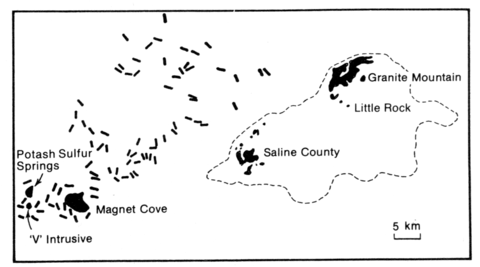stripes
Figs 169 and 172 Geophysical work, later confirmed by drilling, has shown that the Granite Mountain and Saline County intrusions are continuous at depth, the whole complex being referred to as the Little Rock igneous complex by Gordon et al. (1958, p. 67). Their map of the probable extent of the intrusion (Fig. 172) indicates an oval-shaped body of about 50x30 km, making it probably the largest alkaline intrusion in North America, even larger than Coldwell (Canada No. 53). The buried parts of the complex are overlain by Tertiary marine sediments of the Midway Group. Recovered drill core included nepheline syenites of alkali feldspar, nepheline, sodalite, analcime, biotite, sodic amphibole, aegirine, etc., while one rock was free of nepheline but contained abundant analcime. Pulaskites were also recovered, being porphyritic rocks of large alkali feldspars, abundant analcime, biotite, pyroxene and possible nepheline. Fine grained syenitic rocks with a porphyritic or trachytic texture were also drilled, as were somewhat altered dyke rocks of fourchite-monchiquite type.
GORDON, M., TRACEY, J.I. and ELLIS, M.W. 1958. Geology of the Arkansas bauxite region. Professional Paper, United States Geological Survey, 299: 1-268


